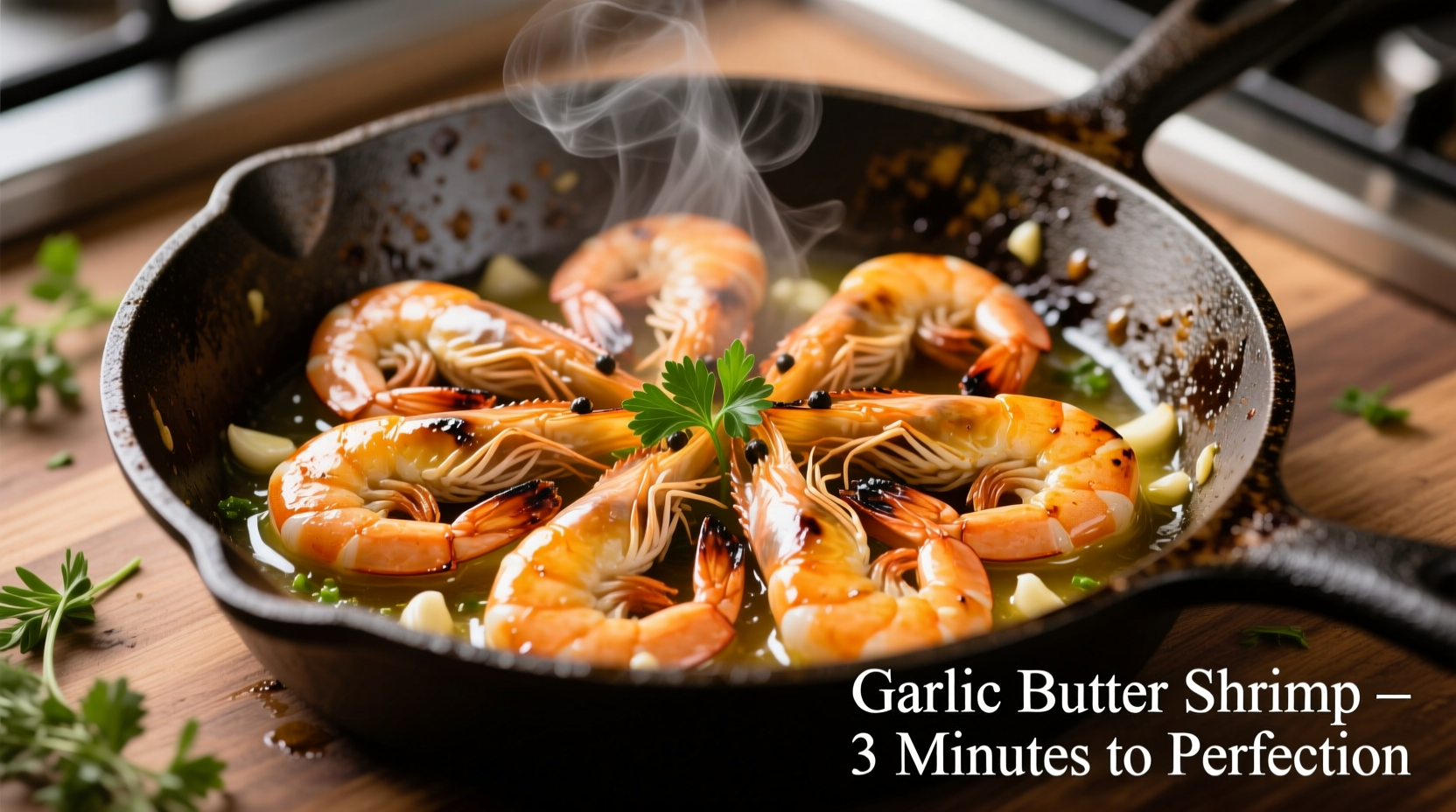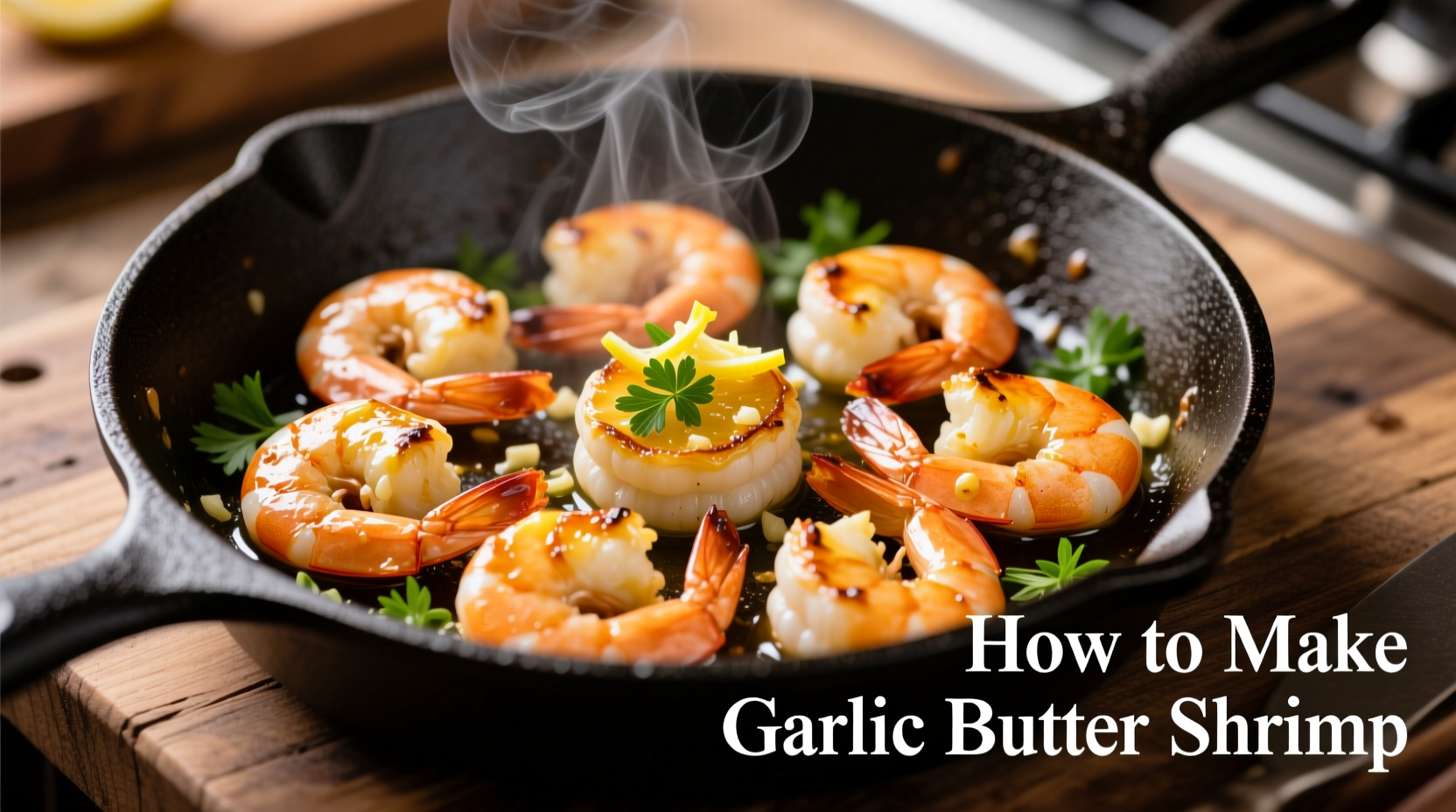Perfect garlic butter shrimp takes just 20 minutes with this foolproof recipe. You'll need 1 pound large shrimp (peeled and deveined), 4 tablespoons unsalted butter, 4 minced garlic cloves, 1 tablespoon lemon juice, 2 tablespoons fresh parsley, salt, and pepper. The secret to restaurant-quality results is cooking shrimp for exactly 2-3 minutes per side until opaque but still tender—overcooking makes them rubbery. This simple method delivers rich garlic flavor without burning the aromatics.
Garlic butter shrimp is the ultimate weeknight dinner solution—elegant enough for guests yet ready faster than takeout. As a chef who's cooked this dish hundreds of times in professional kitchens, I've perfected the timing and technique to guarantee juicy, flavorful shrimp every time. Forget dry, rubbery results; this method leverages food science principles to maximize flavor while preserving perfect texture.
Why This Garlic Butter Shrimp Method Works
The magic happens through precise temperature control and ingredient sequencing. Shrimp proteins begin to denature at 120°F (49°C), becoming tough beyond 140°F (60°C)—that's why timing is critical. Butter's milk solids brown at 250°F (121°C), creating nutty flavors without burning garlic, which scorches at just 212°F (100°C). By adding garlic after butter foams but before full browning, you capture maximum aroma without bitterness.
| Shrimp Size Grade | Count per Pound | Cooking Time | Best For |
|---|---|---|---|
| Extra Large (XL) | 21-25 | 2-3 minutes | Sautéing, grilling |
| Large (L) | 31-35 | 1.5-2.5 minutes | Garlic butter, pasta |
| Medium (M) | 41-50 | 1-2 minutes | Stir-fries, salads |
According to USDA seafood guidelines, shrimp are safe to eat at 145°F (63°C) internal temperature, but removing them from heat at 140°F (60°C) accounts for residual cooking. This temperature precision prevents the protein tightening that causes toughness.
Ingredient Selection Guide
Shrimp quality matters most: Choose "wild-caught" over "farm-raised" when possible for better texture. Look for "undyed" labels to avoid sulfites that affect flavor. Frozen shrimp often outperform "fresh" supermarket shrimp, which may have been previously frozen anyway. Thaw frozen shrimp overnight in the refrigerator for best results.
Butter makes the difference: European-style butter (82%+ butterfat) creates a richer sauce than standard American butter (80% butterfat). Clarified butter allows higher cooking temperatures without burning, but regular butter provides superior flavor complexity from milk solids.
Garlic freshness test: Fresh cloves should feel firm when squeezed. Avoid heads with green sprouts (bitter flavor) or soft spots (sign of spoilage). For consistent mincing, use a microplane grater—it creates finer particles that distribute flavor evenly without burning.
Step-by-Step Cooking Process
Prep Phase (5 minutes)
- Pat shrimp completely dry with paper towels (moisture prevents proper searing)
- Mince garlic and parsley separately (don't mix—garlic burns faster)
- Season shrimp with salt and pepper (¼ tsp salt per pound)
- Have all ingredients measured and within arm's reach
Cooking Sequence (8 minutes)
- Melt butter in stainless steel or cast iron skillet over medium heat (nonstick doesn't create proper fond)
- When butter foams but before browning, add garlic and cook 30 seconds until fragrant
- Add shrimp in single layer—don't crowd the pan (work in batches if needed)
- Cook 2 minutes undisturbed until golden on first side
- Flip and cook 1-2 minutes until opaque through center
- Remove shrimp immediately to prevent overcooking
- Add lemon juice to pan, scraping up browned bits for sauce
- Return shrimp to coat in sauce for 30 seconds
- Finish with parsley and serve

Troubleshooting Common Mistakes
Rubbery shrimp fix: This happens when shrimp cook beyond 140°F (60°C). Solution: Remove from heat when 80% opaque—they'll finish cooking off-heat. For frozen shrimp, reduce cooking time by 30 seconds.
Burnt garlic solution: Garlic burns in just 60 seconds at medium heat. Fix: Cook garlic in cooled butter (remove pan from heat for 10 seconds before adding), or use half butter/half olive oil which has higher smoke point.
Watery sauce remedy: Excess moisture comes from improperly dried shrimp. Always pat thoroughly with paper towels before cooking. If sauce is thin, simmer 1 minute after adding lemon juice to reduce.
Serving Suggestions
This dish shines with simple pairings that won't compete with its delicate flavor:
- Over pasta: Toss with 8 oz linguine and a splash of pasta water for cohesive dish
- With vegetables: Serve alongside roasted asparagus or sautéed spinach
- Rice pairing: Lemon-herb rice absorbs the delicious sauce beautifully
- Wine match: A crisp Sauvignon Blanc cuts through the richness
For meal prep, store components separately: shrimp in airtight container, sauce in separate jar. Reheat sauce first, then add cold shrimp and warm through gently. Never reheat shrimp in microwave—it guarantees rubbery texture.











 浙公网安备
33010002000092号
浙公网安备
33010002000092号 浙B2-20120091-4
浙B2-20120091-4